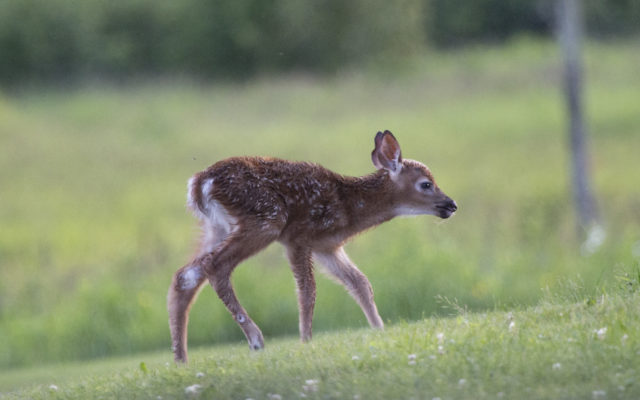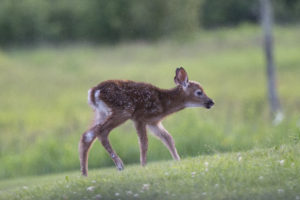
5 ways to attract wildlife to your backyard
If you love wildlife and would like to see more of it around your home, you’re in luck. There are many ways to make your yard more attractive to birds, butterflies and a whole host of other wild creatures.
But first, be prepared. Make sure this is really what you want because when it comes to wildlife, you usually can’t pick and choose exactly what shows up.
Instead, expect a variety. By putting out some bird seed, you might be successful at that — but you’ll also likely lure in squirrels and chipmunks, noisy blue jays and mischievous raccoons. In nature, everything is connected. You might wish to attract colorful songbirds to serenade you in the morning.
For those who are excited to share their outdoor space with more wild animals — scaly, furry, feathered or otherwise — here are a few ways to get started.

Bangor Daily News file photo/Aislinn Sarnacki
White-tailed deer are often spotted in people’s yards in Maine. They forage on a wide variety of plants, including clover and alfalfa.
1. Put out a bird feeder
Placing a bird feeder in your yard is one simple way to encourage more birds to visit. A wide variety of birds regularly visit feeders, and you can cater to specific species by purchasing certain feeder styles or food. For example, suet will often attract woodpeckers, while nyger seeds often attract small birds like goldfinches. And don’t forget hummingbird feeders filled with nectar.
Keep in mind that bird feeders will also likely attract rodents such as squirrels and chipmunks. Also, in the spring — depending on where your home is located — it may attract hungry black bears that have just emerged from hibernation. For this reason, many people put away their bird feeders in the spring, then place them out again for the summer and fall, when food on the landscape is more plentiful for bears. You can also save your bird feeder for winter when birds are hibernating and food may be less plentiful for the birds that stay in Maine to weather the cold months.
2. Plant native food sources
When gardening or landscaping, select plants that serve as food sources for the wildlife species that you would like to see on your property. For example, you can create a butterfly garden filled with flowers that attract butterflies and offer them the nectar they need. Or you could plant berry bushes that will feed birds and other creatures well into the winter.
Often native plants are best for attracting local wildlife because these plants have evolved with the animals on the landscape, forming close relationships. For example, the caterpillars of monarch butterflies have evolved to only eat native milkweed. Also consider cultivating plants that will provide food year round, such as woody plants that produce blossoms, fruit and nuts.
3. Provide different types of shelter
It’s a tough world out there in the wilderness. A spider that catches a fly in its web is soon eaten by a frog, which is picked up by a bird. And on and on it goes. So it’s no surprise that most wild animals prefer to spend time in areas where they can easily seek shelter from any threat.
Bird houses serve as shelters and nesting locations. Rock walls often serve as a home for snakes and chipmunks. Dense bushes provide cover for songbirds, snowshoe hares and other small creatures. And a variety of trees can bring comfort to climbers such as squirrels and porcupines. Tall grass provides cover for ground-nesting birds. Even leaf litter can serve as shelter for animals such as salamanders. Walk around your property and take note of how many places animals have to hide. Could you offer them some more?
4. Keep pets under control
Dogs, cats and other household pets can scare, injure and sometimes kill wildlife. In fact, a 2012 study conducted by scientists from the Smithsonian Conservation Biology Institute and U.S. Fish and Wildlife Service estimated that domestic cats kill 1.3 to 4.0 billion birds and 6.3 to 22.3 billion mammals a year in the U.S. So if you enjoy hosting wildlife in your yard, you may want to consider keeping your pets indoors, leashed or in an enclosure.
It’s also important to note that select wild animals, such as porcupines and animals that are known to carry rabies such as foxes and raccoons, could harm your pets if they are allowed to wander your property unsupervised.
Also, if you’re attracting white-tailed deer and mice to your yard (mice often pursue fallen bird feeder seed), you may be introducing more deer ticks to your property since both species are known to carry the deer tick. Deer ticks, which can carry and transmit a variety of serious diseases, add another potential threat to your pets and yourself. These are all things to consider when planning to attract more wildlife to your property.
5. Offer a fresh water source
Wildlife needs fresh water for drinking and bathing. Providing that water can be as simple as placing a pie plate filled with tap water on the rail of your back porch. Or you could invest in a bird bath or fountain.
The size and shape of the water container you use may be influenced by the type of wildlife you’re aiming to serve. For example, if you want to provide water for a resident garden snake, you might place a shallow container on the ground. If it’s for birds, you can opt for a container that’s higher off the ground and larger, with a good lip for perching.
Refresh the water at least every week and keep the container clean. This helps prevent the spread of disease and thwarts the reproduction of mosquitoes, which breed in standing water.
Really, it’s all about providing wildlife with the necessities of life — food, water and shelter. By making just a few additions or changes to your property, you can make it more appealing to different animals. Some may just visit while passing through while others — like that snake that has built a den in your rock pile — might decide to stay.
Aislinn Sarnacki can be reached at asarnacki@bangordailynews.com. Follow her on Twitter: @1minhikegirl, and Instagram: @actoutdoors.